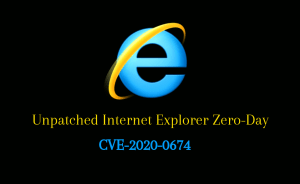Microsoft has released an emergency advisory for an unpatched zero-day vulnerability in Internet Explorer. A vulnerability management tool can detect and fix this. Microsoft is also aware of targets attacks in the wild. This vulnerability discovered by Clement Lecigne of Google’s Threat Analysis Group.
The fix for this zero-day released as a part of the next Patch Tuesday updates. And until then, the vulnerable Internet Explorers would be open to attack. Microsoft added that, this vulnerability exploits when any website utilizing jscript is accessed using a vulnerable IE browser. Using a patch management tool, we can stop these vulnerability exploits.
Update:
360 security experts have attributed the active exploitation of CVE-2020-0674 to an APT group named DarkHotel (APT-C-06). DarkHotel APT is to have an East Asian background and operating since at least 2007. Their main targets include government organizations and enterprises.
CVE-2020-0674 : The scripting engine memory corruption vulnerability
According to Microsoft, CVE-2020-0674 is a remote code execution vulnerability in Internet Explorer due to improper handling of objects in memory by the scripting engine. Successful exploitation could allow an attacker to execute arbitrary code in the context of the current user. If the targeted user has administrative privileges, then the attacker is granted administrator rights after exploitation, which he can use to install programs; view, change or delete data; or create new accounts with full user rights and completely compromise the target system.
Any application which supports embedding Internet Explorer or its scripting engine component would be a potential attack vector for this vulnerability. An attacker can host a malicious website designed to exploit the underlying vulnerability in Internet Explorer or craft HTML documents, PDF files, Microsoft Office documents, or any other documents which support embedded Internet Explorer scripting engine content. A user tricked into visiting the malicious website by clicking on links or convinced to open crafted files delivered through spearphishing emails.
Impact
Also, an attacker can remotely execute arbitrary code on the target system and take control of the entire system in some cases.
Affected Systems
| Internet Explorer 11 | Internet Explorer 10 | Internet Explorer 9 |
|---|---|---|
| Windows 10 for 32/64-bit SystemsWindows 10 Version 1803 for 32/64-bit Systems Windows 10 Version 1809 for Windows 10 Version 1909 for Windows 10 Version 1709 for Windows 10 Version 1903 for Windows 10 Version 1607 for Windows 7 Service Pack 1 for Windows 8.1 for 32/64-bit systems Windows RT 8.1 Windows Server 2008 R2 SP1 Windows Server 2012 Windows Server 2012 R2 Windows Server 2016 Windows Server 2019 |
Windows Server 2012 | Windows Server 2008 for 32/64 bit Systems SP 2 |
Mitigation/Solution
We are not aware of any updates released by Microsoft to fix the vulnerability. However, Microsoft has provided a workaround recommended to be applied by users who are at elevated risk. Implementation of this workaround could result in reduced functionality for components or features that rely on jscript.dll.
Restrict access to JScript.dll
For 32-bit systems, enter the following command at an administrative command prompt:
takeown /f %windir%\system32\jscript.dll
cacls %windir%\system32\jscript.dll /E /P everyone:N
For 64-bit systems, enter the following command at an administrative command prompt:
takeown /f %windir%\syswow64\jscript.dll
cacls %windir%\syswow64\jscript.dll /E /P everyone:N
takeown /f %windir%\system32\jscript.dll
cacls %windir%\system32\jscript.dll /E /P everyone:N
NOTE: This workaround must be reverted before installing any future updates.
Update:
0patch has provided a micropatch for CVE-2020-0674 which acts a ‘kill switch for vulnerable jscript.dll’. This patch is also known to avoid the negative side effects of Microsoft’s workaround. When Microsoft releases a patch for this vulnerability, it will be superior to the enabled micropatch.
We will continue to monitor this vulnerability and update as and when a fix is available. It is suggested for users to be extremely cautious before opening any suspicious links or documents which might trigger the vulnerability

